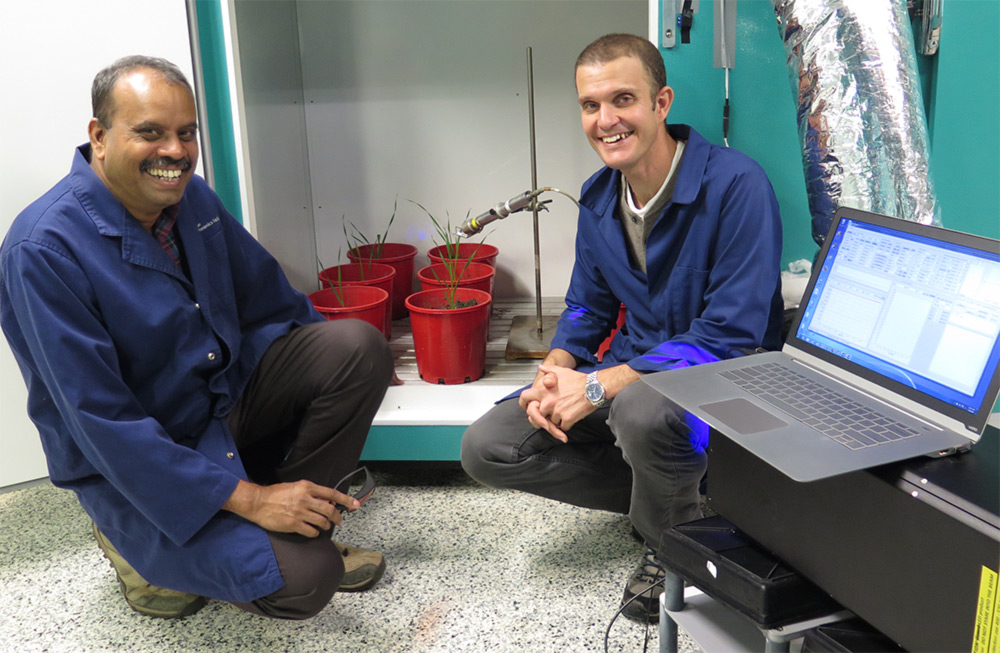Australia
July 24, 2018




Arun Shanker and Robert Coe at the HRPPC, the Australian Plant Phenomics Facility’s CSIRO hosted node
-
An international collaboration tackling a shared challenge – the search for combined heat/drought tolerant crops
-
Investigating how photosynthesis and electron transport pathways in wheat behave under combined stresses
-
Building expertise and institution-to-institution connections between India and Australia through Endeavour Scholarships and Fellowships
They say ‘when the going gets tough, the tough get going’ but plants can’t just move on when the climate gets tough. What defences do they bring into play to withstand the stresses of heat and drought; often a nasty ‘dynamic duo’? The affect these stresses have on the development and yield of our crop plants is keenly studied by researchers, however, the physiological basis of combined tolerance is yet to be clearly understood.
What is particularly interesting for Drs Arun Shanker (Principal Scientist, CRIDA) and Robert Coe (Scientist, HRPPC, CSIRO node of the Australian Plant Phenomics Facility) is how the photosynthesis and electron transport pathway behaves under these combined stresses. To dig deeper into this mystery, they have partnered to work on a project entitled “Integrated high-resolution phenotyping, chlorophyll fluorescence and photosystem II dynamics in wheat under water and heat stress” as part of an Executive Endeavour Fellowship Arun received from the Australian Government’s Department of Education and Training.
“My aim is to study chlorophyll fluorescence, photosystem II and the individual quantitative physiological parameters by phenotyping drought and heat stress in wheat. My hypothesis is that during exposure to abiotic stress, specific strategies are employed by plants, such as structural and functional changes in the photosynthetic systems by which they acquire new homeostasis, which may aid in protective adaptations”, explained Arun.

 L-R: Monitoring PAM, Arun Shanker and infra-red imaging of wheat
L-R: Monitoring PAM, Arun Shanker and infra-red imaging of wheat
Arun is a Principal Scientist, specialising in plant physiology, biochemistry and molecular biology – with a focus on pearl millet and maize – with the Indian Council of Agricultural Research (ICAR) at Central Research Institute for Dryland Agriculture (CRIDA) in Hyderabad, India. His combined drought/heat stress research is part of a flagship project on climate change in India, the National Innovation in Climate Resilient Agriculture (NICRA), a network project of the ICAR.
With India and Australia sharing similarly hot climates and frequent droughts, Arun hopes his experience with millet and maize will bring valuable insight to the wheat project, and in turn, he will develop skills in high-throughput phenotyping by working with Robert and the APPF team to help accelerate his research in India.
Robert recently returned to the APPF’s CSIRO node after a number of years working with the International Rice Research Institute (IRRI) in the Philippines on the C4 Rice Project, providing expertise on high-throughput phenotyping equipment and chlorophyll fluorescence imaging. Upon overseeing the installation of the first high-throughput Cropatron system in the Philippines, he and Richard Poire (from APPF’s ANU node) also provided training to IRRI staff.
“Collaborating with Arun on this project has been really enjoyable. Having spent a number of years working in Asia with IRRI, our research interests have many overlaps. Ultimately Arun will be able to return to his research in India with a specialised skill set in phenomics and high-throughput phenotyping which will contribute to his long-term goal of evolving climate ready cultivars”, said Robert.
Arun and Robert have now begun to process and analyse their data from the 4-month project, which will wrap up in early August, with the view to publish their results.
Endeavour Scholarships and Fellowships offer achieving individuals from Australia and overseas the opportunity to develop their knowledge and expertise, build institution-to-institution connections and create the next generation of international education and research leaders across a wide variety of professional fields. Read more here.
More about Dr Arun Shanker – Arun is very active in social media in his efforts to popularise plant science. He has many interests including astronomy, philosophy, general biological science and, most importantly, climate change. He can be contacted here.
More about Dr Robert Coe.
For more on drought/heat stress research at the APPF including a new, first-of-its-kind combined stress research capability available to scientists, click here.